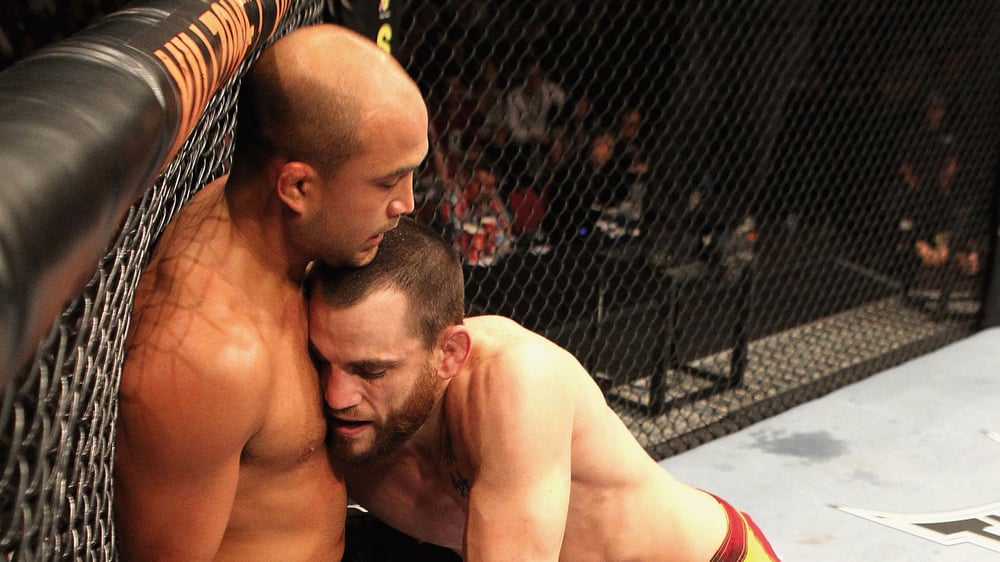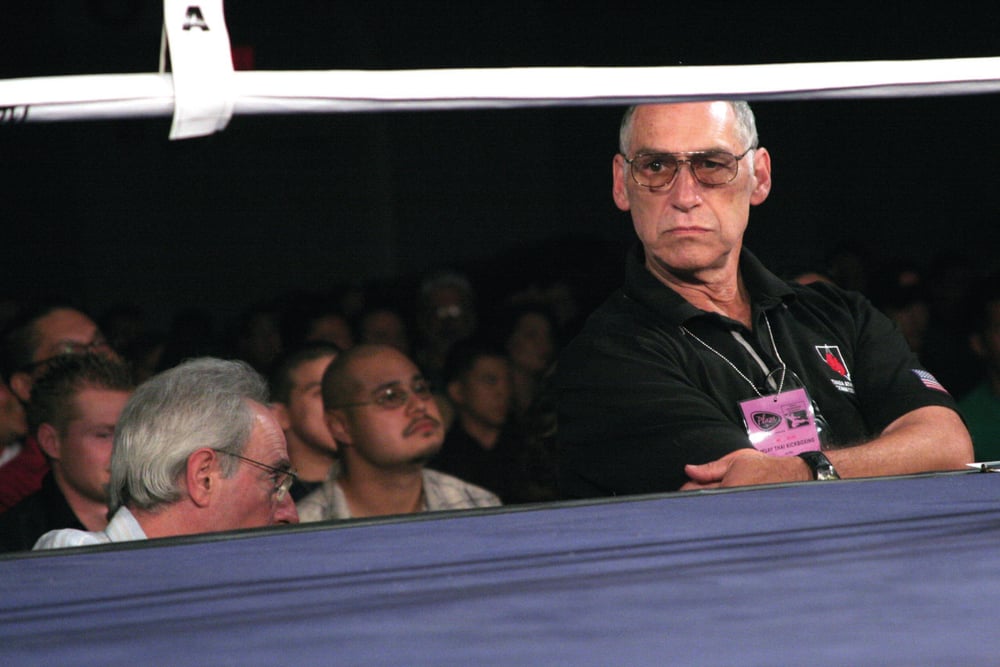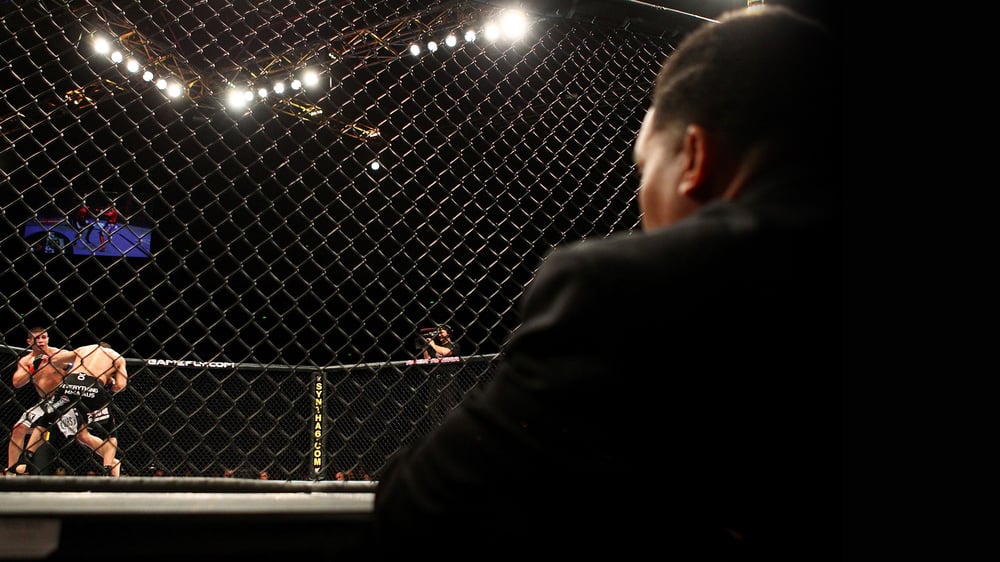
Issue 081
November 2011
Draws, split and questionable decisions are the bane of the cage these days. FO investigates, is it the officials or the criteria that is to blame?
With three judges scoring every fight using the 10-9 system, close fights will often divide all three minds, even if they are all following the same outlines as stated in the Unified Rules of MMA. Regardless of which fighter Bruce Buffer announces as the winner by split decision, the crowd will still boo and no majority decision will please everyone. The subjectivity of judging is a necessary evil we cannot remove, but that doesn’t mean we should accept the failings of the current system as unchangeable.
‘Don’t leave it in the hands of the judges’ is not an acceptable excuse when a man’s livelihood is at stake. Fighters Only set out to establish the judging issues in MMA.
The judges
When a decision goes against consensus the most popular point of contention is the judges themselves. They are often ridiculed for simply not knowing enough about MMA. However, Keith Kizer, executive director of the Nevada State Athletic Commission, insists this is not the case. Nevada chooses its judges from a pool of 12 to 15 officials, who have many years of judging experience before reaching major promotions like the UFC (see ‘Becoming a Judge’ page 81).
“They have to show prior experience with amateur shows or in another jurisdiction. And I don’t mean weeks or months,” says Kizer. “Sitting at home scoring a fight is easy, you have to be able to cope with the world knowing you got it wrong. It’s a lot of stress and some people just don’t like doing it.”
Contrary to some opinion, appointing judges is not simply a case of “jobs for the boys,” where positions are awarded based on influence or friendships with the right people. One such myth suggests those who judge boxing immediately transfer to judging MMA, a sport they do not understand fully. But in the state of Nevada at least, this is not the case. “We only have three judges who score both sports and they have extensive MMA experience. I’ve heard with other commissions it might be more regular, but not here,” Kizer states.

That statement indicates one of the largest issues in judging: there is no unified governing body deciding who has the capabilities to be a judge. There is no mandatory universal requirement for judges to have passed any test proving their knowledge of the sport. In California, they must go through either Herb Dean or ‘Big’ John McCarthy’s schools to be qualified to judge, and several other states follow a similar route. But not anywhere near every state has such provisions, while internationally this issue is increased further.
At the moment, even in Nevada, someone could judge for many years without having detailed knowledge of the criteria. It is feasible that someone could get to judge a UFC card by showing a sound, but far from comprehensive, knowledge of MMA techniques and the judging criteria itself. Considering the increasing number of decisions as baffling as the one rendered in the Darren Elkins vs Michihiro Omigawa fight at UFC 131, it may even have happened.
After making a bad decision, the judge in question should logically be held accountable for their actions. Kizer says: “Immediately post-event I will ask for an explanation of any questionable scores. Sometimes the explanation is great and it makes me re-assess how I scored the round. Other times, it’s not so great. But you can’t throw away years of experience based on one bad call. If a judge is consistently performing poorly, I’ll suggest they re-train or go back to the amateurs.
“In rare cases, their license will not be renewed at the end of the year. During my tenure, that has happened to around one person per year.” Nevada are policing poor judging but just like in the case of training judges, what applies in one state does not apply in every area.
As well as the lack of a worldwide-recognized training program and universally high levels of accountability, a possible issue is the pay that judges receive for their toils. On average, a judge working most events in Nevada will earn between $7,000 and $13,000 a year. “Judging is not a career in itself,” says Kizer. “In Nevada, working a UFC PPV earns you around $900 for the whole card. And we pay better than most, if not all, territories.” When even the very best judges in the world do not earn enough for it to be a full-time career, how can we expect anywhere near perfection from them?
But at least improvements are occurring, such as the introduction of video monitors for UFC judges. Kizer said: “They have proven very popular. There is no replays, no audio and they are adjustable so the live fight is still within your peripheral vision.”

Judging criteria
The current judging criteria was written when mixed martial arts was underground and barely considered a sport. As such, the criteria reflects early MMA pioneers like Jeff Blatnick and John McCarthy’s attempts to gain mainstream approval to prevent MMA being declared illegal. This has left one of the most crucial elements of a fight missing from the criteria: damage.
In order, the current criteria consists of: effective striking and grappling, control of the fighting area, and effective aggression and defense. But MMA is a combat sport, and combat is about damaging your opponent. But there is another system, outside of the current 10-point-must, which accounts for that.
Currently being trialed by the California MMA Organization (CAMO), via amateur fights in their state, is Nelson ‘Doc’ Hamilton’s MMAS system, more commonly known as the ‘half-point’ system. CAMO’s president, JT Steele, revealed: “Many people think Doc’s system is just about using half-points, but it isn’t. The heart of the system is that damage is the first criteria by which to judge a fight. That is what these fighters are trying to do; damage their opponent. So it’s logical that we first look at damage.”
Although this presents an additional problem of defining exactly what is meant by damage, it could be an improvement on the current criteria.
Another area of the present guidelines gains much unfair criticism: control of the fighting area. However, on closer inspection, our focus should lie elsewhere.
Control of the fighting area is defined as who is “dictating the pace, location and position of the fight” and it is only to be considered if effective grappling and striking are even. Clearly, if you are dictating the pace and location of a fight, that is an advantage over your opponent.
The last criterion of the current system is arguably the most perplexing. ‘Effective aggression’ is defined as “moving forward and landing a legal strike or takedown.” How can effective aggression be different from effective striking and grappling? That ambiguity in the criteria has allowed fighters like Diego Sanchez (against Martin Kampmann) and Leonard Garcia to win decisions based on swinging wildly and continually chasing their opponent, without necessarily landing effective strikes or takedowns. Once again, this flaw is erased by the MMAS system, which counts effective aggression and defense under the cage control heading.

Scoring system
The current scoring system, originally used in boxing, is the ‘10 point must’ system, where the winner of a round is scored 10 points and the loser 9. Scores of 10-8 and 10-7 are rare, but also possible. This produces a problem, as a narrowly winning a round is often scored the same as clearly winning. While 10-10 rounds are perhaps not quite as rare, it is unusual for a round to see completely even action from both fighters.
In theory, the MMAS system, which is viewed as the only viable alternative by commissions across the US, solves this problem by the introduction of half points.
Having experimented with half points in amateur MMA for the past six months, JT Steele believes the feedback is clear. “In very close rounds, 10-9 often doesn’t tell you much, but 10-9.5 does,” he says. “Fighters and judges have unanimously said it better reflects the action in a bout. In MMA, we need a finer gradient like this, because it is only three rounds (except title fights and now main events), not 12 (as in boxing).”
Although the feedback appears to be positive, there are detractors. One of the main criticisms is that it will not actually produce any changes and judges will resort to using 10-9.5 scores the same way as they currently use 10-9 scores, with 10-9 becoming the new 10-8.
However, based on 155 bouts this year, CAMO has produced data that appears to dispel that critique. For those fights, judges recorded scores using both the 10-point must and MMAS systems. The results indicate only 11% of all scorecards turned out differently. Kizer acknowledges: “The half-point system gives the judges more tools and I’m in favor of that, but where do you stop? Do you introduce quarter points, and if not, why not? My colleague in Tennessee, Jeff Mullen, says the half point should be used only when a judge is genuinely torn. If that happened, that could be okay.”
The reason for judges not overly using the 10-9.5 score appears to be the MMAS systems’ definition of what constitutes each score. “One of the best things about MMAS is it helps the official understand when to give a 10-9 or 10-8. It does the best job of fleshing out the criteria, no other system is as thorough,” says JT Steele.

A potentially negative element of the MMAS system also emerges from the CAMO data. From 155 bouts, 27.5% of fights have ended in a split decision, majority decision or draw, the outcomes that draw the greatest ire from fans. By contrast, only 7.5% of UFC fights during that time have ended in the same fashion.
Another aspect of MMAS that has suffered disapproval is the introduction of a fourth ‘table’ judge, who only decides the winner in the event of a draw. The fourth judge uses a martial arts system where techniques are given points, akin to amateur wrestling. “The fourth judge doesn’t assess damage or any other criteria, he just objectively measures techniques. No one likes a draw, and this is a way to potentially avoid that outcome,” Steele adds.
For the record, CAMO have not yet decided if they will continue to use the system beyond this year as they are keen to ensure it is flawless before introducing it permanently or recommending it to others.
Conclusion
There is no guarantee a revamped judging process would reduce the recent plethora of contentious decisions – even with better judges, better criteria and an improved scoring system. But that doesn’t mean we should accept the current flaws. JT Steele says it best: “Some places are okay with judges’ performances and use subjectivity as an excuse. But when paychecks are on the line, that only goes so far.”
Alternative scoring methods
- Nelson ‘Doc’ Hamilton’s MMAS, or half-point, system.
- Pride-style judging the fight in its entirety.
- Amateur wrestling scoring, where points are objectively awarded for particular techniques.
- Gymnastics scoring, where fighters gain overall individual scores out of 10.

Ugly decisions
Particularly horrific decisions in the past year:
- Omigawa vs Elkins
- Phan vs Garcia
- Ring vs Fukuda
And main events shrouded in controversy:
- Sanchez vs Kampmann
- Jackson vs Machida
- Penn vs Fitch
Becoming a judge
- Know MMA. Be a long-term connoisseur of the sport and the intricacies of grappling and striking.
- Go on a training course and become an expert with the criteria outlined in the Unified Rules.
- Start out small on local amateur or semi-pro shows.
- After a few years of good work, progress to professional MMA undercards, starting by watching and shadow-judging
- Enter the big time. Then after a year or two of shadow judging and scoring under card bouts, take on the main card.
- Prove yourself capable of handling the pressure for two to three years on the main card and gain a slot judging a UFC title shot.
- Information according to Keith Kizer and relates solely to the Nevada commission.
2011 UFC decisions*
- Total fights 159
- Decisions 80
- Unanimous 69
- Majority 1
- Splits 8
- Draws 2
- *Up to UFC Live 5










